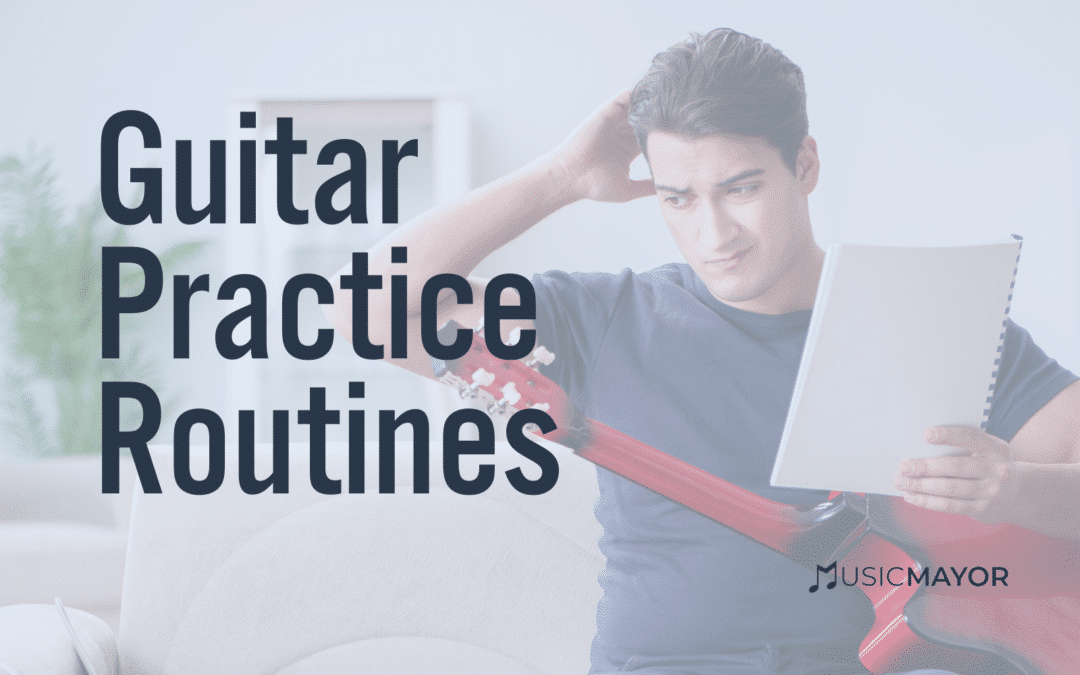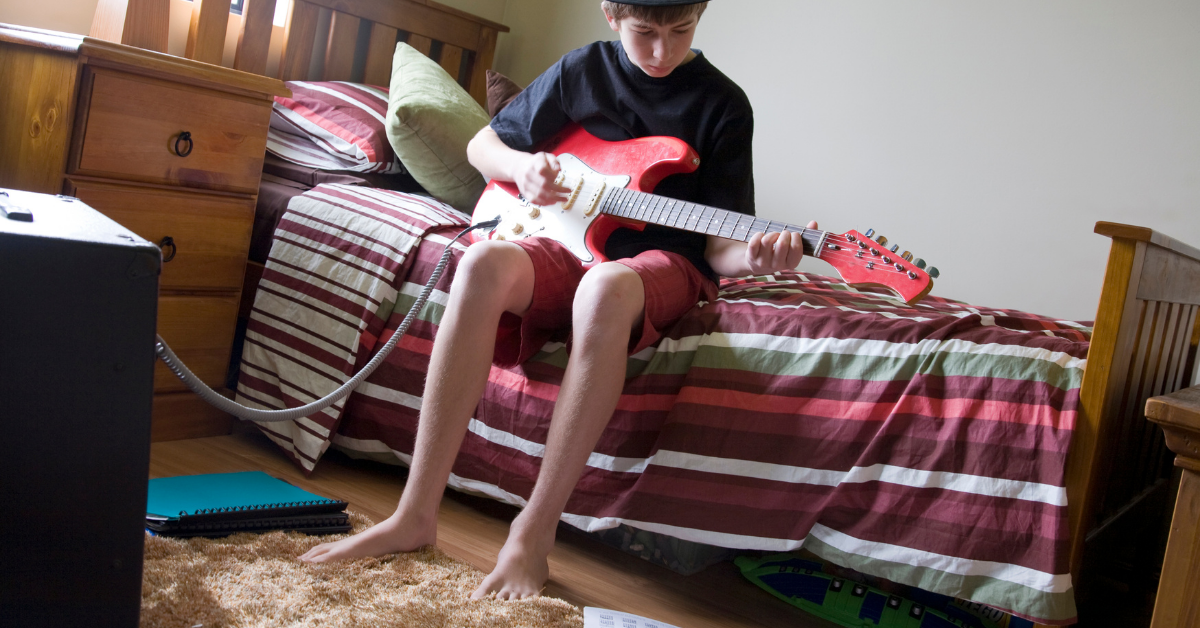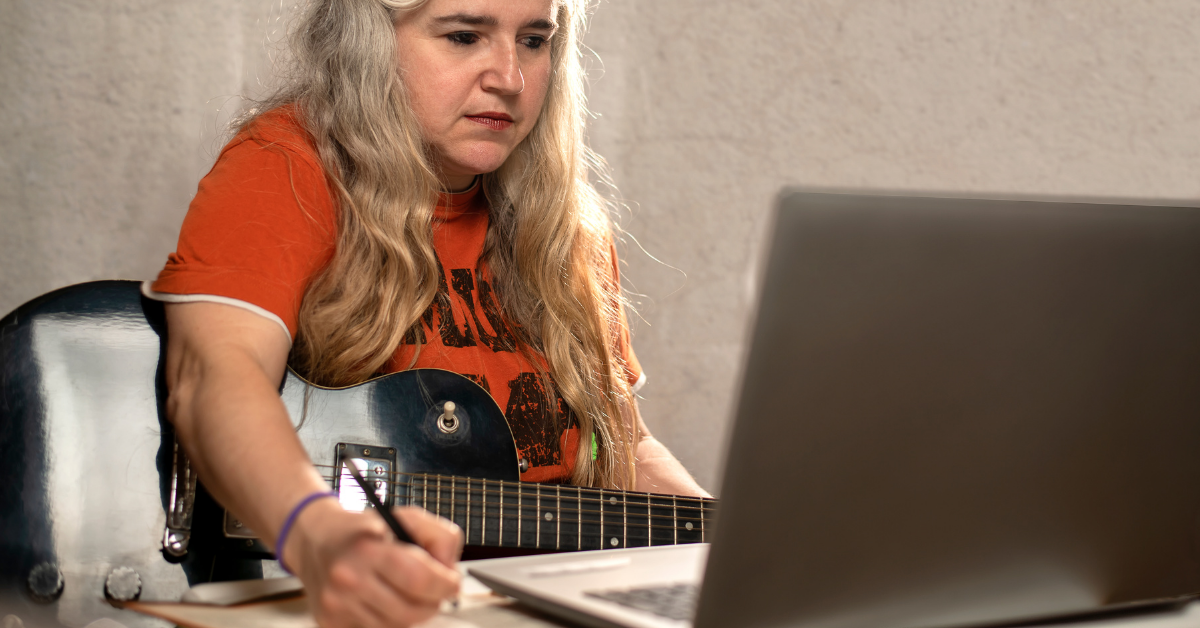If you want to become a better guitar player, you’ll need to find the best guitar practice routine for you.
Guitar practice routines help a person to perform in the study and practice of music with greater consistency and productivity.
Many times we don’t know where to start or which path to take when it comes to learning, and we end up wasting time in repetitive and not very didactic lessons that end up diminishing our performance. The guitar practice routines will be useful to get the most out of our instruments and optimize our learning.
How to plan a guitar practice routine?
Planning a guitar practice routine requires the player to consider what their goals are with the instrument and what they hope to get out of a routine. Not everyone plays the guitar guided by the same interests and because of this, not everyone will have the same routine.
While some people require continuous practice for four or five days a week, others may reserve two or three days of practice only.
On the other hand, the content of the routine will also depend on the person’s interests. The guitar is a very versatile instrument that has been applied to many musical genres and that has given rise to many specific sonorities (see the guitar and the genres). In this way, when we think about playing the guitar we can find many paths to take, each with different lessons and skills to learn.
Of course, when you have no previous knowledge of the guitar or music in general, it is to be expected that learning will be standardized. All beginner musicians usually encounter the same learning pattern and then, having mastered the basics, can decide to take the path they like best.
So, in general, the following tips can be followed to start a guitar routine:
● Identify what goal is achieved by learning the guitar.
● Establish weaknesses in theory and practice that require further attention.
● Point out the most important points that can help us reach our goal.
● Set a timetable adapted to our availability and trying to cover all the content required to achieve the proposed goal.
What examples show that a guitar practice routine pays off?
The practice of the guitar, as well as any other discipline, requires a good methodology if you want to achieve good results. A guitar practice routine will not only allow a person to better allocate their time, but will also help them develop the concepts and lessons they require with greater order and precision. These advantages are present no matter what kind of music we want to play, and we, the people who play the guitar or any other instrument, can witness them in the following contexts of everyday life:
● When we belong to a musical group and require an efficient way to allocate our time between rehearsing and continuing to learn.
● When we study music at a high school and we have to prepare a repertoire of songs with our instrument in a certain amount of time.
● When we have to play a song that requires the use of new skills in playing the instrument.
● When we must train our ability to improvise without the need to use notation.
● When we have to share the study of music with some other occupation, such as work or a university degree.
In all these cases the use of a guitar practice routine can help us to obtain good results with our instrument and at the same time have a good performance in the rest of our activities.
How should we structure our guitar practice routine?
In order to structure our guitar practice routine we must identify which concepts or lessons we should favor in order to achieve the expected results. There are many things we could learn or practice, but we are not going to focus on all of them, but on a specific set based on our level, interests and goals.
For example, if we want to learn to play the guitar to build the harmonic base that will support the voice or an instrument like the violin, we should give priority to lessons on chords and arpeggios rather than scales. Also, if we wanted to learn to play classical guitar we should focus on the proper techniques for playing classical songs rather than on the rhythms and melodies of popular music. It is very important for the musician to know which themes he should dedicate his time to in order to obtain the expected results.
Now, at the moment of structuring the routine it is also fundamental that we distinguish between theoretical lessons and practical lessons. Only the person doing their routine can know how much time they will need to spend on music theory (see the purpose of music theory). In this way, while aiming to achieve competent guitar playing, you can also include the theoretical study time necessary to understand what you are playing.
How long should we practice?
The time to practice the guitar will depend on the requirements of each person and the availability that he/she has. Not all musicians will have the same routine and, therefore, not all musicians will have the same intensity in the development of their lessons. While some people only require two or three days a week to complete the required lessons and understand the topics they are studying, others will require up to five or six days a week in order to assimilate new concepts and performance techniques.
Then, to know how much practice time is required, it is necessary to analyze the density of the routine and identify the difficulty of the lessons. For difficult and complex lessons we can spend more time than the simpler and more understandable lessons. Then, having determined the lessons and their difficulties, the musician can decide whether to increase or decrease the hours of practice, all based on his or her own performance.
Can we use online courses for our practice routines?
We can use online courses for our practice routines, but we must be careful about the type of online course we take. The online guitar courses can offer us properly structured content so that the musician can follow the lessons in a progressive and continuous way, but some others could have a disordered and not very didactic structure. Thus, we must consider all possible options and select those courses that best suit our needs.
On the other hand, we must also determine the relevance that the online guitar course could have in our practice routine. For example, we could use the online course in the following ways:
● As a reference to know which concepts we should study.
● To guide us completely with the timetable and lessons set by the course.
● To reinforce very specific topics and lessons that we cannot understand on our own.
Then, we can explore the various online guitar courses and, based on our needs, complement our practice routine with the course content.
How should we practice when we are beginners?
When we are beginners one of the biggest difficulties to play the guitar is the mobility of the hands on the instrument. If we have no previous experience on an instrument such as the piano, bass or any other stringed instrument, it is to be expected that our hands are not capable of making clean sounds on a guitar. Therefore, when we are beginners we should have a greater focus on the development of our motor skills and, in turn, on the assimilation of the basic aspects of music and the instrument.
Every beginning musician must first know the fundamentals of music as a discipline and of his or her instrument, no matter what his or her goals are. Thus, taking into account that the intensity and constancy of the practices depend on the musician’s objectives, the following aspects can be taken into account:
● The characteristics of the guitar should be studied from the beginning so that the musician knows the functionality of the instrument in his hands.
● A large part of the practice should be devoted to exercises to speed up the mobility and strength of the hands.
● Along with the exercises, you can study the most basic scales and chords, such as the C major scale and the barbless major and minor chords.
● If the musician wishes, he can attend introductory guitar courses to complement his practice routines.
5 great exercises for your practice routine!
▷GUITAR◁ Fender Custom Shop Telecaster: 2018...
How to practice if we are intermediate or advanced musicians?
When we already have an intermediate or advanced level of knowledge and experience with the guitar, our interests play a very important role. At this point we must adapt our routines according to the techniques and concepts that are required to achieve the desired interpretation. Thus, there is no single way to practice the guitar, but the following tips can be followed and adapted to each person’s routine:
● Place an audio track in some key convenient for the musician and improvise with the help of scales.
● Study modal scales and practice them with the use of the different chords we get from harmonizations.
● Trying to get a familiar song out on the guitar without the need to resort to musical notation.
● Practice the songs with a metronome and increase the speed progressively to improve hand agility.
● Try to play more complex songs once you have mastered the previous ones.
● With the aid of musical notation, theory, and skill on the instrument, compose melodies and harmonic bases.
What guitar exercises can we take as an example?
If you don’t know where to start or what guitar exercises could be added to a practice routine, the following exercises could be used as a reference:
For the mobility of the fingers on the neck
For the mobility of the fingers on the neck we must make sure, first of all, that the thumb stays in the middle of the neck. Then, we proceed to place the other fingers on the first string (the highest E string), each one on a different fret, side by side. Once in this position, the index finger is raised and lowered from the first to the sixth string, maintaining the position of the rest of the fingers.
Once you have enough dexterity with the index finger, proceed to perform the same procedure with the middle finger, ring finger, and little finger. It is important to take care that the position of the fingers that are not moving is maintained throughout the exercise.
For the speed of the hand plucking the strings
To increase our string plucking speed we can practice plucking with the help of a metronome. That is, with a plectrum or with the index and middle fingers, eighth notes can be played on the first string at a tempo appropriate to the musician’s ability.
We can set the metronome to 90 bpm and play until we master the tempo. We then proceed to increase the speed progressively until we reach, for example, a speed of 200 bpm.
Ideas to enjoy guitar practice
Guitar practice should not only be limited to repetitive exercises and long music theory lessons. The practice, as well as the music itself, should be creative and enjoyable for the person learning. Thus, the following tips could be followed to make the tedious guitar practice a moment to exploit our creativity and make the most of it:
● Regardless of our skill, we should play songs we like in addition to songs chosen by a teacher or a guide.
● If we are unable to successfully perform an exercise or a song, we can change the practice or find another piece of music.
● If we think of a melody, we can try to play it with the guitar and start composing a piece. If something sounds wrong, we change it and keep practicing.
● Listen to music and explore with genres and artists we have not heard before.
● Analyze the playing techniques of our model guitarists and try to imitate them.
How to be a self-taught guitarist?
To be a self-taught guitarist it is necessary to have a lot of discipline in order not to lose motivation in the learning process. If we decide to learn to play the guitar on our own, it would be very convenient to establish a routine so that we don’t get confused and study concepts or lessons that are not suitable for our level.
At the same time, online guitar courses are a great help for self-taught musicians. In fact, the musician could take the online course just to know what things he should study. On the other hand, the routine can become very productive if the person practicing performs his or her own exercises. For example, the musician could take some reference exercises and then, from them, perform more complex exercises of his own devising.
The self-taught musician must be very creative to maintain a good performance. The structure of the theoretical and practical lessons must be boldly made to compensate for the absence of an experienced person, such as a music teacher or tutor.
How do professional guitarists practice?
To practice like professional guitarists do we must focus more on quality rather than quantity. That is, instead of focusing on doing many types of exercises, we should try to do a few, but ensure that the execution is error-free. Thus, by mastering a few exercises with a good playing technique, we guarantee that when we play a song the sounds are clean and error-free.
At the same time, the care in the tempo of the songs is essential for every musician. The use of the metronome may seem trivial, but every professional musician must master its use no matter what tempo he or she may face.
Finally, the practice of the guitar should be aimed at the excellence of the technique that the musician applies to produce the desired sounds, but also to the enjoyment of the music and the emotions expressed with it.




